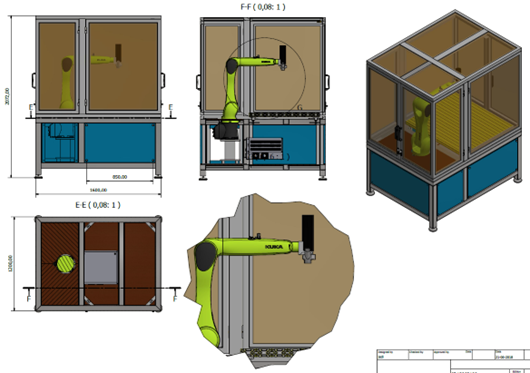An ambitious start
The AM-KUGA pilot originated during the joint SUSTAIN-3D meeting hosted by Thomas More University in February 2024. During this event, CFI and its Danish partners were introduced to Thomas More’s groundbreaking work combining robotic arms with 3D printing for large-scale manufacturing. The scalability and flexibility of this technology sparked the idea to replicate and adapt it in Denmark, with a dual focus on supporting SMEs and enhancing STEM education.
CFI partnered with MERCANTEC to build a robotic 3D printing unit using a KUKA robotic arm, integrating insights from the Component Recommendation Report. This collaboration has also benefited from input by Herningsholm AM Learning Lab, which is developing a similar system with a focus on proof of concept. These efforts demonstrate how cross-border collaboration can inspire innovative pilots that address both industrial and educational challenges.
Challenges in Execution
Despite the inspiring potential of the AM-KUGA pilot, the project has encountered several challenges:
- Integration complexity: Combining the robotic arm with a 3D printing head and programming non-planar printing paths has proven technically demanding.
- Educational adaptation: Developing user-friendly systems suitable for vocational education requires additional considerations, such as safety measures and ease of use, given that the system will be operated infrequently.
- Component selection: The selection of appropriate components, such as extruders, software, and build platforms, required extensive testing to ensure they meet both industrial and educational needs.
- Resource and infrastructure demands: Building a robotic 3D printing system demands significant time, resources, and infrastructure, which has stretched available capacities.
These challenges highlight the need for precise planning, collaboration, and knowledge-sharing to ensure the successful implementation of this advanced technology.
Alignment with SUSTAIN-3D Goals
The AM-KUGA pilot directly supports the objectives of the SUSTAIN-3D project by addressing key barriers to AM adoption among SMEs and educational institutions. Specifically, the pilot seeks to:
- Create demand: Demonstrate the potential of robotic 3D printing for both manufacturing and educational purposes, encouraging broader adoption.
- Build capacity: Equip SMEs and schools with the knowledge and tools needed to integrate AM technologies into their workflows and curricula.
- Foster innovation: Showcase how robotic systems can expand design possibilities and enable new applications of AM technology.
Furthermore, the pilot aligns with SUSTAIN-3D’s focus on skills, services, and infrastructure by providing a practical demonstration of how advanced AM technologies can be adapted for both industrial and educational contexts.
Positioning within the Local Action Plan
The AM-KUGA pilot is a key element of CFI’s Local Action Plan under the SUSTAIN-3D framework. It addresses the need for accessible infrastructure and innovative solutions to support SMEs while also enhancing STEM education. By collaborating with MERCANTEC and leveraging the insights from the Component Recommendation Report, the pilot ensures that the technology can be effectively integrated into vocational schools.
This dual focus on industry and education strengthens the link between Danish SMEs and vocational schools, creating a sustainable ecosystem for the adoption of advanced AM technologies. Additionally, by building on the recommendations in the Component Recommendation Report, the pilot ensures that the system is safe, user-friendly, and scalable for educational use.
What have we learned
Although the AM-KUGA pilot is still in progress, several key lessons have emerged:
- Collaboration matters: Partnerships with educational institutions like MERCANTEC and cross-border stakeholders such as Thomas More University are critical for addressing technical and educational challenges.
- Tailored solutions for education: Adapting AM technologies for teaching purposes requires additional considerations, such as safety, ease of use, and modularity.
- Resource planning: Developing large-scale robotic AM systems demands significant resources and infrastructure, which must be carefully planned and allocated.
- Component selection: Identifying the right balance between cost, performance, and usability is essential for meeting the needs of both SMEs and educational institutions.
The way forward
The AM-KUGA pilot has not only advanced the development of large-scale robotic 3D printing in Denmark but has also inspired the submission of a new Erasmus+ application. This new project focuses on developing teaching materials for robotic 3D printing technologies, which remain relatively uncommon yet hold significant potential, particularly for 3D printing in metals.
The teaching materials will build on the findings in this pilot to address the unique requirements of non-planar and large-scale 3D printing. By integrating these materials into STEM education, the project aims to prepare students for the future of manufacturing while also making advanced AM technologies more accessible to SMEs.
As the AM-KUGA pilot progresses, its outcomes will continue to inform and inspire new initiatives. These efforts will foster collaboration between SMEs, vocational schools, and international partners, ensuring that Denmark and EU remains at the forefront of AM innovation and education. Through these initiatives, the AM-KUGA pilot will play a pivotal role in driving the adoption of advanced AM technologies across industries and regions.
Read more about the Component Recommendation Report here
